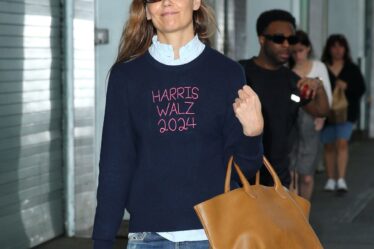
The popularity of its retro sneakers, as well as its Gazelle, Campus and Handball Spezial shoes, was the main driver of last week’s upgrade to forecasts for full-year operating profit to about €700 million ($745.4 million) from €500 million.
But Adidas shouldn’t become too reliant on the low-rise sneakers with rubber soles — certainly not as it was with Kanye West’s Yeezy line. A profit warning last week from Dr Martens Plc, and the departure of its chief executive officer Kenny Wilson, is a salutary lesson in what happens when shoppers move on from a signature style.
For Adidas, a similar plight looks some ways off. Of the €200 million profit upgrade, about €50 million came from selling the remaining Yeezy inventory. This implies that the rest is coming from demand for core Adidas products, which are being led by what are known as the Terrace shoes, a reference to their adoption by 1980s football fans. Indeed, analysts estimate sales growth excluding Yeezy and currency movements at about 5 percent, compared with 2 percent for the Nike Inc. brand in the three months to the end of February. This is reflected in Adidas shares, which are at their highest level for two years.
According to analysts at RBC Capital Markets, cycles where either Nike or Adidas are dominant typically last three to five years. Assuming Adidas’ growth overtakes Nike’s for the first time in five years in 2024, then it should mean a few more years on top.
But there are signs that Adidas CEO Bjorn Gulden’s strategy to maximize sales of the Samba may be starting to weigh on its popularity.
The supply of Sambas to US and UK retailers’ websites between January and April 17 rose 354 percent from 2023, according to retail intelligence company EDITED. Yet the proportion selling out of a majority of sizes and variations fell 17 percentage points to 51 percent. That’s not a disaster given the amount of stock Adidas is pumping into the market, and that it was probably struggling to keep up with demand last year, but it’s a warning that the style could become ubiquitous.
Gulden already seems to be aware of the risk. For example, the Handball Spezial has emerged as the hottest Terrace style in recent months. Adidas appears to be following the Samba playbook and ramping up output. Arrivals are up 300 percent so far this year, according to EDITED, but sellouts rose 6 percentage points to 56 percent, indicating continued consumer appetite.
Even so, Gulden must be on watch for any rebalancing toward Nike or his former employer Puma SE, which offers a suite of Terrace-style shoes.
Nike seems more focused on regaining its prowess in athletic footwear, with new versions of Alphafly and Pegasus — the centerpiece of its running business — unveiled in Paris last week. It is also intensifying its efforts in women’s sportswear, with the expected endorsement of star college basketball player Caitlin Clark.
Indeed, retro low-rise sneakers tend to be cheaper — selling slightly above or below $100 — and therefore less profitable than basketball or running shoes. But they could help to rebuild brand buzz — something that Nike badly needs — if they can be produced quickly enough, and in sufficient volumes and colors, to piggyback on the trend.
This may be why Nike is already rereleasing a selection of styles, including an all-white leather Cortez, favoured by “The Bear” star Jeremy Allen White, and the Field General. But the company should go further. For example, the all-white Cortez sold out in the majority sizes within one month of landing, according to EDITED.
Gulden isn’t the only leader who needs to be trend-obsessed over the coming months.
Michelle Gass, CEO of Levi Strauss & Co., is enjoying a sales lift from the shift from slim fitting jeans, which ruled for more than a decade, to wider-legged pants. Baggy styles for men and women rose 40 percent in the first quarter. But interest in skinny fits is rising again. Luckily for Gass, it takes time for the jeans juggernaut to turn. She can still get ahead of any narrowing in the silhouette.
One way to deal with the danger of star products falling out of favor is to have plenty of other options. Gulden seems to be thinking ahead, planning for where the trend might go next. Not only is he leaning into the Spezial, but he is taking the Terrace trend into running, with the reissued SL72 — also selling out strongly according to EDITED — while delving into the archive for other low-rise styles, dubbed “Lo Profile.”
And he is seeking to replicate the success of the three stripes — a key part of the Terrace trend — in clothing. After spotting Blake Lively alongside Taylor Swift in a red Adidas tracksuit at the Superbowl, the company is offering a variety of fits in 12 different colours.
Similarly, Gass is capitalising on strong demand for denim to sell more non-jean items, such as denim skirts, dresses, jumpsuits and tops, as well as non-denim categories that consumers tend to replenish more often, such as T-shirts.
Both should learn from Dr Martens. Although it offers sandals and clogs, its main focus is the chunky boot. These had a fashion moment three to four years ago — around the time the company listed in London — but have now waned in popularity, leading to a series of profit downgrades.
Gulden seems to be on the opposite trajectory, under-promising and over-delivering. But with the Terrace look maturing and competition intensifying, he must put his best Samba-clad foot forward to keep Adidas’s profit and share-price recovery on track.
By Andrea Felsted
Learn more:
How Adidas Sambas Took Over the World
The humble trainer, once the reserve of football fans, Britpop kids and the odd skateboarder, has become as ubiquitous as battered Converse All Stars in the 00s indie sleaze years.



